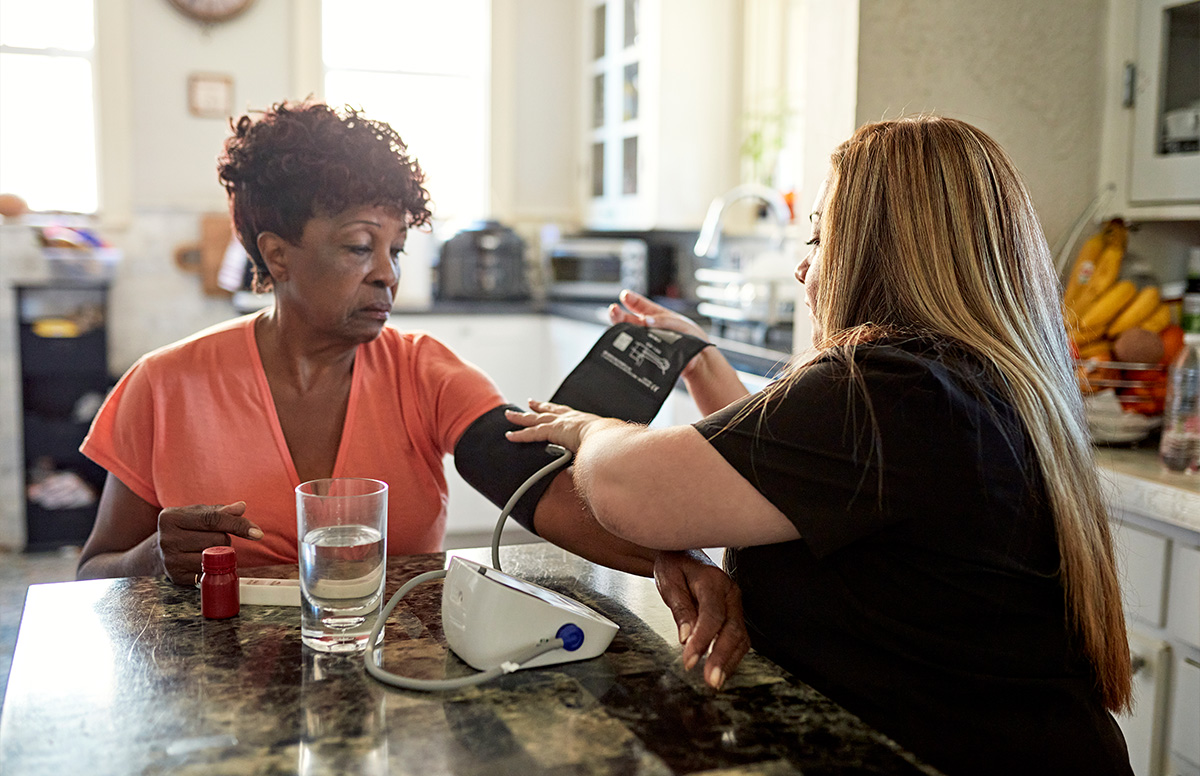Home Health CY2024 Prospective Payment Final Rule Summary
Home » Home Health CY2024 Prospective Payment Final Rule Summary
The final CY2024 Home Health Prospective Payment System Rate Update Final Rule was released on the Federal Register public inspection site on November 1, 2023, and is scheduled for publication in the Federal Register on November 13.
The final CY2024 Home Health Prospective Payment System Rate Update Final Rule was released on the Federal Register public inspection site on November 1, 2023 and is scheduled for publication in the Federal Register on November 13.
This summary is not exhaustive; we encourage members to read the whole rule. The public inspection copy of the rule linked here. A copy of the fact sheet which accompanied the rule is available here.
Join the Home Health Network here or email Katy Barnett.
Finalized CY2024 Permanent and Temporary Adjustment Calculations
CMS finalized a -2.89% permanent adjustment to the CY2024 national, standardized 30-day payment rate based on the application of CY2022 data to the current payment methodology. This is roughly half of the originally proposed reduction of -5.653. Similar to last year, CMS stated when reducing the permanent adjustment, they would need to implement a greater rate reduction in future years. While the proposed rule calculated the total temporary adjustment in the CY2024 proposed rule (approximately $3.5 billion), CMS did not propose a temporary adjustment for CY2024.
Finalized CY2024 Home Health Payment Rate Updates
CMS estimates that Medicare payments to home health agencies (HHAs) in CY2024 will increase in the aggregate by 0.8%, or $140 million, compared to CY2023, based on the finalized policies. This increase reflects the effects of the 3.0% home health payment update percentage ($525 million increase), an estimated 2.6% decrease that reflects the net effects of the finalized prospective permanent behavioral assumption adjustment across all payments (half of the full adjustment), as the adjustment applies only to the national, standardized 30-day period payments and does not impact low utilization payment adjustments (LUPAs) ($455 million decrease), and an estimated 0.4% increase that reflects the effects of an update to the fixed-dollar loss ratio (FDL) used in determining outlier payments ($70 million increase).
TABLE B36: FINAL CY2024 NATIONAL, STANDARDIZED 30-DAY PERIOD PAYMENT AMOUNT
| CY2023
National Standardized 30-Day Period Payment
|
Permanent
Behavioral Adjustment Factor
|
Case-Mix
Weights Budget Neutrality Factor
|
Wage
Index Budget Neutrality Factor
|
CY2024
HH Payment Update
|
CY2024
National, Standardized 30-Day Period Payment
|
| $2,010.69 | 0.97110 | 1.0124 | 1.0012 | 1.030 | $2,038.13 |
For HHAs that do not submit the required quality data for CY2024, the home health payment update would be 0.9% (2.9% minus 2 percentage points).
TABLE B37: FINAL CY2024 NATIONAL PER-VISIT PAYMENT AMOUNTS
| HH Discipline | CY2023 Per-Visit Payment Amount | Wage Index Budget Neutrality Factor | CY2024 HH Payment Update | CY2024 Per-Visit Payment Amount |
| Home Health Aide | $73.93 | 1.0012 | 1.030 | $76.23 |
| Medical Social Services | $261.72 | 1.0012 | 1.030 | $269.87 |
| Occupational Therapy | $179.70 | 1.0012 | 1.030 | $185.29 |
| Physical Therapy | $178.47 | 1.0012 | 1.030 | $184.03 |
| Skilled Nursing | $163.29 | 1.0012 | 1.030 | $168.37 |
| Speech-Language Pathology | $194.00 | 1.0012 | 1.030 | $200.04
|
Finalized CY2022 Rebased and Revised Home Health Market Basket and Labor-Related Share
CMS finalized their proposal to rebase and revise the home health market basket from 2016 base to reflect a 2021 base year using October 1, 2020, to October 1, 2021, cost reports for freestanding home health agencies. This is the most complete year of data. CMS also proposes to revise by using different data sources, cost categories, and price proxies use in the input price index. CMS plans to monitor for COVID implications and make adjustments in future years.
Finalized CY2024 Patient Driven Grouping Model (PDGM) Low Utilization Payment Adjustment (LUPA) Thresholds and PDGM Case-Mix Weights
For CY2024, CMS finalized to update the LUPA thresholds, functional impairment levels and comorbidity subgroups using CY2022 home health claims utilization data (as of March 17, 2023).
The final rule lists the revised LUPA Thresholds and case mix weights for all 432 case mix weights on Table B12 in the final rule. Members should review these changes and assess their impact on the agency. This is especially important for the LUPA changes. Members need to be aware of any Home Health Resource Group (“HHRGs”) where the LUPA threshold will increase for 2024.
CMS finalized to update OASIS functional points as follows:
- M1800: Grooming – no change
- M1810: Current Ability to Dress Upper Body – no change
- M1820: Current Ability to Dress Lower Body – Response 2 decreased from 4 to 3 points and Response 3 decreased from 12 to 11
- M1830: Bathing – Response 2 decreased from 1 to 0 points, Response 3 or 4 decreased from 9 to 7, Response 5 or 6 decreased from 17 to 14
- M1840: Toilet Transferring – Response 2, 3 or 4 – increased from 5 to 6
- M1850: Transferring – no change
- M1860: Ambulation/Locomotion – Response 3 – decreased from 5 to 4
- M1033: Risk of Hospitalization – Four or more items – increased from 10 to 11
The comorbidity subgroups for CY2024 reflect the finalized coding changes included in table B9 and B10 of the final rule.
Finalized Fixed-Dollar Loss (FDL) Ratio Changes for Outlier Payments
Using CY2022 claims data, CMS is finalized an FDL ratio of 0.27 for CY2024 which is lower than the initial proposal of .30%.
Finalized for Disposable Negative Pressure Wound Therapy (dNPWT)
The Consolidated Appropriations Act of 2023 mandates several amendments to the Medicare separate payment for dNPWT devices beginning in CY2024. For the purposes of paying for a dNPWT device for a patient under a Medicare home health plan of care, CMS finalized the payment amount for CY2024 of $263.25.
Request for Information (RFI) for Access to Home Health Aide Services
In the CY2024 HH PPS proposed rule, CMS solicited comments from the public regarding information related to promoting the appropriate access to and provision of home health aide services for all beneficiaries receiving care under the home health benefit. This final rule includes a discussion on the comments received regarding access to home health aide services, key takeaways include:
- Broadly, comments stated that the decline in the utilization of home health aide services is not indicative of a reduced need for such services and while substantial home health aide hours are allowed, the actual provision is dwindling, especially affecting those with chronic or long-term conditions, who often require a combination of skilled and aide.
- Both CMS’ and home health agencies’ policies, practices, and current payment model (PDGM) have resulted in barriers that devalue and disincentive the provision of these essential services.
- Multiple commenters stated that HHAs’ engage in selective practices and strategic preference for serving lower acuity patients to maximize profits and suggested that CMS has not fulfilled its oversight and enforce responsibilities regarding the nondiscrimination conditions of participation for Medicare-certified HHAs.
- Commenters identified multiple barriers affecting recruiting and retaining aides, including low compensation, competition for labor in different job markets, inadequate/limited training opportunities, and demanding work conditions. They also noticed wage disparities between home health aides and similar positions in nursing homes and hospitals.
- Solutions to these recruitment and retention barriers included improved compensation, including aide services more directly in care plans, providing advanced training, and establishing centralized systems for employee development.
- A commenter stated that CMS’s episodic reimbursement for home health does not support robust staffing, particularly in rural areas where separate visits for home health aides could not be justified when other professionals could complete the work in the scope of their practice.
- When it comes to Medicare and Medicaid coordination of these services, commenters shared that the effectiveness of coordination varies by state and is generally limited (especially for dually eligible beneficiaries) compounded by systemic issue arising from differences in eligibility, coverage, and administrative factors.
- Multiple commenters stated that HHA’s limited aide services though convincing physicians not to write orders by stating aide services are either very limited or not available at all, refusing to initiate aide services unless family/caregivers commit to learning how to perform the aide functions themselves or refusing to staff aides adequately or understaffing them deliberately.
- Commenters identified consequences to beneficiaries’ including outcomes such as unnecessary hospitalizations, nursing facility admissions, potentiated health complications, family/caregiver burnout, and even forced institutionalizations.
The feedback provided by respondents will help guide CMS’s policy formulation processes, and they are hopeful this information can assist in refining policy development, addressing barriers, and fostering coordination under the home health benefit for future regulatory updates. CMS did note that any suggestions related to payment, which is statutorily required, should be directed towards Congress.
Home Health Quality Reporting Program (HH QRP)
Finalized Measures for 2025
CMS finalized adoption of a new outcome measure, Discharge Function Score (DC Function), in the HHQRP beginning with the CY2025 HHQRP. This assessment-based outcome measure evaluates functional status by calculating the percentage of HH patients who meet or exceed an expected discharge function score. CMS will replace the topped-out, cross-setting “Percent of Long-Term Care Hospital Patients with an Admission and Discharge Functional Assessment and a Care Plan That Addresses Function” process measure with this new measure.
HHAs will report these assessment data in OASIS beginning with patients discharged between January 1, 2024, and March 31, 2024, for the CY2025 HH QRP. Starting in CY2024, HHAs will submit data for the entire calendar year beginning with the CY2026 HH QRP. CMS will begin publicly displaying data for the DC Function measure beginning with the January 2025 refresh of Care Compare, or as soon as technically feasible, using data collected from April 1, 2023, through March 31, 2024, (Quarter 2 2023 through Quarter 1 2024). HHAs that have fewer than 20 eligible cases would be distinguished with a footnote that notes that the number of cases/patient stays is too small to report.
CMS also finalized the adoption of a new process measure, COVID–19 Vaccine: Percent of Patients/Residents who are Up to Date (Patient/Resident COVID–19 Vaccine) beginning with the CY2025 HH QRP. Despite concerns from LeadingAge and other participants on the Consensus Based Entity which reviews quality measures for federal programs, CMS is moving forward. The measure reports the percent of home health patients that are up to date on their COVID–19 vaccinations per CDC’s latest guidance. This measure has no exclusions and is not risk adjusted.
HHAs will report these OASIS assessment data beginning with patients discharged between January 1, 2025, and March 31, 2025, for the CY2025 HH QRP. Starting in CY2025, HHAs will submit data for the entire calendar year beginning with the CY2026 HH QRP. CMS will begin publicly displaying data for the COVID–19 Vaccine measure beginning with the January 2026 refresh of Care Compare or as soon as technically feasible using data collected for Q2 2024 (April 1, 2024, through June 30, 2024).
Finalized Public Reporting Health Information Measures
In addition to these two new measures, CMS finalized its proposal to begin publicly displaying data for the measures: (1) Transfer of Health (TOH) Information to the Provider—Post-Acute Care (PAC) Measure (TOH-Provider); and (2) Transfer of Health (TOH) Information to the Patient—Post-Acute Care (PAC) Measure (TOH-Patient). CY2025 CMS will begin publicly displaying data for the TOH-measures beginning with the January 2025 refresh of Care Compare, or as soon as technically feasible.
Finalized OASIS Changes
For the OASIS tool, CMS plans to remove two OASIS items, the M0110—Episode Timing and M2220—Therapy Needs effective January 1, 2025. These items are no longer used in the calculation of quality measures already adopted in the HH QRP, nor are they being used currently for previously established purposes unrelated to the HH QRP, including payment, survey, the HHVBP Model or care planning. HHAs that have fewer than 20 eligible cases would be distinguished with a footnote that notes that the number of cases/patient stays is too small to report.
Finalized To Codify HH QRP Data Completion Thresholds
CMS finalized their proposal to codify data completeness thresholds at § 484.245(b)(2)(ii)(A) for measures data collected using the OASIS. Under this section, CMS codifies requirements that HHAs must meet or exceed a data submission threshold set at 90% of all required OASIS and submit the data through the CMS designated data submission systems. This threshold applies to required quality measures data and standardized patient assessment data collected adopted into the HH QRP. CMS is also codifying a policy at § 484.245(b)(2)(ii)(B) that a HHA must meet or exceed this threshold to avoid receiving a two-percentage point reduction to its annual payment update for a given CY as codified at § 484.225(b). This is consistent with the FY2023 Hospice Proposed Rule as well.
Principles for Selecting and Prioritizing HH QRP Quality Measures and Concepts Under Consideration for Future Years: Request for Information (RFI)
CMS included another RFI to gather input on existing gaps in HH QRP measures and to solicit public comment on either fully developed HH measures, fully developed measures in other programs that may be appropriate for the HH QRP, and measurement concepts that could be developed into HH QRP measures, to fill these measurement gaps. CMS plans to prioritize these measures by the four following objectives: actionability, comprehensiveness and conciseness, focus on provider responses to payment, and alignment with CMS statutory requirements and key program goals. Common comments included:
- Support for the CMS principles and criteria for selecting and prioritizing measures.
- Concerns that the proposed principle of “provider responses to payment” raises concerns due to the ambiguity of the term “unwanted responses.”
- Requests for stakeholder engagement (for example, technical expert panels, and review and analysis of beneficiary and family input) as a guiding principle.
- Suggestion to include a guiding principle related to discontinuing metrics without continually adding more metrics given the burden the constant addition of metrics places on agencies.
- Add the principle of Timeliness and Clarity of CMS data, described as promoting increased availability and frequency of data with lesser time lag, and clarity around the reportability and feedback of data to and from CMS and in compliance with QRP.
- Recommendation for incorporating “objectivity” as a principle, described as prioritizing claims-based measures over provider reported measures in order to mitigate measure manipulation.
- Recommendation to prioritize measures for which data elements are clearly defined, valid, and well standardized.
Overall, commenters focused on voicing their opposition to the CMS’s emphasis on reducing hospitalizations and keeping patients in the community as the gold standard for quality performance in the home health setting. This was described as a longstanding frustration for HHAs and a disincentive to care for patients with complex health needs, contributing to some HHAs avoiding servicing patients with complex needs. Opposition was justified by highlighting the growing number of medically complex patients coming from community rather than post-acute care referrals, and recognition that home health agencies have limited ability to prevent hospitalizations with many complex patient populations/patient conditions. For patients with complex and/or chronic care needs, measures that address delays in transfers to higher levels of care may be a better reflection of quality home health care and transfers to the hospital or a skilled nursing facility may ultimately be an appropriate discharge disposition. A stratification approach for quality measurement for patients with chronic illnesses and complex needs was also described as an appropriate alternative.
Commenters also provided feedback on initial gaps identified by CMS:
- Cognitive Function and Behavioral and Mental Health
- Overall, there was significant opposition to the implementation of a measure related to cognitive function and/or behavioral health. Commenters stated that such measures would not make sense as performance measure domains in home health care due to limited time, resources, and expertise to provide interventions that would directly impact a patient’s cognition, behavioral and/or mental health.
- Others suggested this was an area for the Center for Medicare and Medicaid Innovation (CMMI) or another entity looking at how to better serve older adults with cognitive and/or behavioral or mental health needs.
- One gap that was identified and recommended for future exploration in relation to cognitive function was the need for HHAs to better identify mild cognitive impairment. Current assessments (BIMS, CAM, and PHQ-9) are not sufficient to identify mild and mild to moderate cognitive impairment.
- Many suggested that CMS pause adding additional metrics until there are more data to determine whether BIMS and CAM are effective and if they are not effective, the assessments should be replaced, not added on top of with other measures.
- Chronic Conditions and Pain Management
- Overall, support for exploring gaps and performance measures related to chronic illness in the home health setting, but emphasized these should focus on maintenance or stabilization of chronic conditions rather than improvement.
- Support for continuing to include these metrics more comprehensively within the case mix weight, rather than adding additional metrics and further exploration of measures that assess quality of life for the beneficiary and the family caregiver in relation to chronic illness.
- Commenters supported CMS’s effort to align quality measures across care settings through the Universal Foundation and strongly support CMS focusing efforts on developing performance measures around chronic conditions.
- Commenters stated that although current measures are directed at managing chronic illnesses, many are physician focused and more development is needed to address chronic illness in the home health setting.
- Others suggested CMS should measure the effect of appropriate interventions for those patients that are expected to decline.
- There was also support for a stratification approach for quality measurement for patients with chronic illnesses and complex needs.
- Pain Management
- Commenters supported further exploration of gaps in measurement related to pain management in home health, particularly the assessment of pain and its effect on sleep, therapy activities, and day-to-day activities and function.
- Many voiced confusion regarding CMS’ decision to remove this domain as a performance measure in home health due to the opioid crisis.
- Commenters recommended standardized assessments as the best metric to evaluate pain, including the standardized pain scale 0-10, Wong-Baker, and PAINAD and emphasized the need to have options.
- Encouraged CMS to identify tools that can address the inequities in pain assessment and treatment, specifically among African Americans.
- Other Measure Gaps
- Addressing social risk for patients, including financial needs
- Support for caregivers and caregiver status, and assessment including adding Caregiver Status to post-acute assessment tools
- Treatment and referral for patients with chronic obstructive pulmonary disease.
- The Social Need Screening and Intervention HEDIS measure was also recommended
- COPD measures recommended including, Referral to Smoking Cessation Counseling or Program, Referral to Pulmonary Rehabilitation Clinic, and COPD GOLD Strategy treatment for HH patients.
- Advance care planning (ACP)
- The Depression Screening and Follow-Up for Adolescents and Adults (DSF)
- Person-centered care outcome (PCO) measures
- Commenters also suggested incorporating end of life including the new patient-reported quality measure “Felt Heard and Understood” (already endorsed by the CBE), a measure on referral or access to palliative care and a measurement of timely and appropriate referral to hospice
Finalized Changes to the Expanded Home Health Value-Based Purchasing (HHVBP) Model
CMS finalized four changes to the HHVBP applicable measure set.
First, CMS codified the eight HHVBP measure removals factors effective in CY2024 to make the program consistent with other CMS quality reporting programs including the home health quality reporting program as noted above. These factors include:
- Factor 1. Measure performance among HHAs is so high and unvarying that meaningful distinctions in improvements in performance can no longer be made (that is, topped out).
- Factor 2. Performance or improvement on a measure does not result in better patient outcomes.
- Factor 3. A measure does not align with current clinical guidelines or practice.
- Factor 4. A more broadly applicable measure (across settings, populations, or conditions) for the particular topic is available.
- Factor 5. A measure that is more proximal in time to desired patient outcomes for the particular topic is available.
- Factor 6. A measure that is more strongly associated with desired patient outcomes for the particular topic is available.
- Factor 7. Collection or public reporting of a measure leads to negative unintended consequences other than patient harm.
- Factor 8. The costs associated with a measure outweigh the benefit of its continued use in the program.
Second, CMS finalized the removal of five measures from the current applicable measure set and addition of three measures starting in CY2025.
Measures finalized for removal:
- OASIS-based Discharged to Community (DTC);
- OASIS-based Total Normalized Composite Change in Self-Care (TNC Self-Care);
- OASIS based Total Normalized Composite Change in Mobility (TNC Mobility);
- claims-based Acute Care Hospitalization During the First 60 Days of Home Health Use (ACH); and
- claims-based Emergency Department Use without Hospitalization During the First 60 Days of Home Health (ED Use).
Measures finalized for inclusion:
- Claims-based Discharge to Community-Post Acute Care (DTC-PAC) Measure for Home Health Agencies;
- OASIS based Discharge Function Score (DC Function) measure; and
- Claims-Based Home Health Within-Stay Potentially Preventable Hospitalization (PPH) measure.
Third, due to the net change in the number of measures proposed, CMS is finalizing adjustments to the weights for the measures in the OASIS-based and claims-based measure categories starting in CY2025. However, they will add the weighting of measure categories to the agenda for the TEP planned for November of this year and share these comments with the HHVBP Technical Expert Panel (TEP) and will monitor to determine if the measures will impact beneficiaries of lower socioeconomic status.
- Claims-based:
- Discharge to Community: 9 for large volume agencies and 12.857 for small volume agencies
- Potentially Preventable Hospitalization (PPH): 26 for large volume agencies and 37.143 for small volume agencies
- OASIS-based:
- Discharge Function Score (DC Function): 20 for large volume agencies and 28.571 for small volume agencies
Lastly, CMS finalized the Model baseline year for all measures starting in CY2025.
CMS also finalized an amendment at § 484.375(b)(5) to specify that an HHA may request Administrator review of a reconsideration decision within seven days from CMS’s notification to the HHA contact of the outcome of the reconsideration request.
Finalized Medicare Home Intravenous Immune Globulin (IVIG) Items and Services
The CAA 2023 added coverage and payment of items and services related to administration of IVIG in a patient’s home of a patient with a diagnosed primary immune deficiency disease furnished on or after January 1, 2024.
Payment for these items and services is required to be a separate bundled payment made to a supplier for all administration items and services furnished in the home during a calendar day. The standard Part B coinsurance and the Part B deductible will be applied.
In addition, the statute states that the separate bundled payment for these IVIG administration items and services does not apply for individuals receiving services under the Medicare home health benefit. These changes were finalized in the rule.
Finalized Changes to the Provider and Supplier Enrollment Requirements
In addition to the hospice specific program integrity proposals finalized in the CY2024 Home Health Proposed Rule, CMS includes additional provisions impacting all Medicare providers and suppliers including hospices.

Most Recommended
October 15, 2025
 Shutdown Week Three: Impact of Ongoing Closure on Affordable Housing
Shutdown Week Three: Impact of Ongoing Closure on Affordable Housing
December 10, 2025
Fiscal Year (FY) Funding 2026
October 07, 2025
Immigrant Workforce Matching Program Brings Workforce Relief
Recently Added
December 17, 2025
 Colleagues on the Move, December 17, 2025
Colleagues on the Move, December 17, 2025
December 16, 2025



